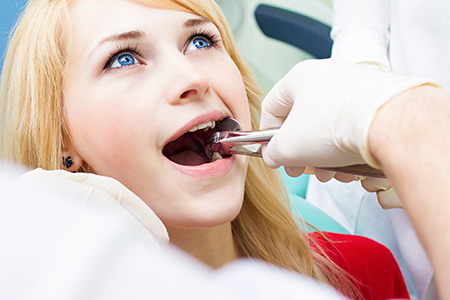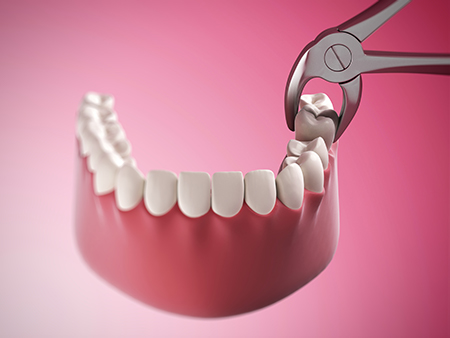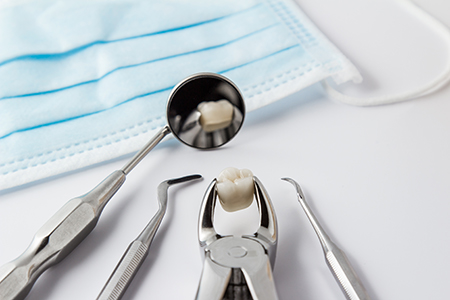
Your dental team’s priority is preserving natural teeth whenever possible, but there are times when removing a tooth is the safest path to protect long-term oral health. An extraction can stop the spread of infection, prevent damage to adjacent teeth, and remove sources of persistent pain. Approaching extractions thoughtfully helps patients avoid future complications and maintain overall wellness.
Decisions about removing a tooth take into account your full medical and dental history, current symptoms, and imaging findings. When a tooth cannot be predictably restored or is harming the structures around it, extraction can be the most conservative and preventive option. We aim to explain the rationale clearly so you can feel confident in the recommended course of care.
Every extraction is individualized. Factors such as root anatomy, surrounding bone level, gum health, and the presence of infection influence both whether a tooth should be removed and how the procedure is planned. When possible, we recommend replacement options so that the function and appearance of your smile can be restored after healing.
Primary (baby) teeth that won't fall out
Sometimes a deciduous tooth stays attached long after its permanent successor is trying to erupt. When the baby tooth's roots fail to resorb or the tooth fuses to the bone, it can block normal development. Removing an over-retained primary tooth can allow the permanent tooth to come in properly and reduce future orthodontic concerns.
Irreparable decay or structural damage to a permanent tooth
When decay reaches deep into the tooth or a tooth is broken beyond restoration, trying to save it may not be in your best interest. In those cases, extraction removes a source of infection and pain and prevents the problem from affecting neighboring teeth or the jawbone.
Severe fractures that compromise the root or supporting bone
Some fractures extend beneath the gumline or into the root, making restoration unreliable. When the remaining tooth structure cannot support a crown or filling, extraction can eliminate persistent symptoms and allow for a predictable rebuild with restorative options later.
Advanced periodontal disease affecting tooth support
Progressive gum disease destroys the soft tissues and bone that hold teeth in place. When a tooth is no longer stable because of bone loss or deep infection, removing it can help preserve the health of surrounding teeth and make ongoing periodontal care more effective.
Impacted or problematic wisdom teeth
Third molars frequently lack the space to erupt properly and can cause crowding, decay, or chronic inflammation. Extracting problematic wisdom teeth—especially before they lead to more complex issues—can simplify future care and reduce the risk of recurrent infections.
Teeth removed as part of orthodontic planning
In some modern orthodontic cases, removing select permanent teeth creates the space needed to align the smile efficiently and achieve a healthy bite. Extractions for orthodontic reasons are carefully coordinated with your orthodontist so the overall treatment plan remains stable and predictable.

Before any extraction, a thorough evaluation identifies the least invasive approach that will achieve a predictable outcome. This evaluation includes a review of your medical history, an oral exam, and appropriate imaging to reveal root shape, bone level, and nearby anatomical structures. Clear planning reduces surprises and helps set realistic expectations for recovery.
Medical conditions and current medications can affect the timing and technique of an extraction. We’ll review your health information and coordinate with your physician when necessary. In certain situations, additional precautions—such as altering medication schedules or prescribing a short course of antibiotics—may be recommended to protect your health.
When exam findings are complex, referral to an oral and maxillofacial surgeon may be advised. Such specialists focus on advanced surgical situations, but many routine extractions and thoughtfully planned surgical removals can be performed in our practice with local anesthesia and appropriate comfort measures.
For teeth that are fully visible and have uncomplicated root shapes, a simple extraction is typically quick and efficient. Local anesthetic numbs the area so you remain comfortable while the tooth is loosened and removed using gentle instruments. The goal is to preserve as much bone and tissue as possible to support healing.
Surgical extractions are used for teeth that are broken at the gumline, impacted, or fused to surrounding bone. These procedures may involve a small incision and limited removal of bone to gain access. Even with surgical techniques, careful anesthesia and post-operative planning aim to minimize discomfort and accelerate recovery.

Patient comfort is central to the procedure. Local anesthesia reliably blocks sensation at the site, and many patients find that the injection itself is the most uncomfortable moment. To ease anxiety, we explain each step and offer measures such as topical numbing agents and calming techniques to make the experience more manageable.
For those with higher levels of anxiety or for longer, more complex procedures, additional sedation options may be discussed. Conscious sedation helps patients remain relaxed while breathing on their own; deeper sedation or general anesthesia is reserved for cases that truly require it and is coordinated with appropriate monitoring and safety protocols.
Throughout the appointment, we monitor your condition and follow strict infection-control and safety practices. Expect clear verbal instructions before, during, and after the procedure so you understand what to expect and how to support an uncomplicated recovery.
Healing after an extraction is a gradual process that is helped by following practical aftercare steps. Initial bleeding is normal and controlled with gauze and gentle pressure. Keeping activity moderate, avoiding dislodging the clot, and following medication guidance all support uncomplicated healing and reduce the chance of complications.
We provide tailored post-operative instructions depending on the complexity of the extraction. Simple extractions usually have shorter recovery periods, while surgical extractions can require a few extra days of rest and care. Monitoring swelling, managing discomfort with recommended medications, and maintaining gentle oral hygiene are key elements of recovery.
If, at any point, bleeding, increasing pain, or unusual symptoms appear, contact the practice promptly so we can assess healing and intervene if needed. Early communication allows complications to be addressed quickly and conservatively.
Maintaining gauze pressure
After the extraction, bite gently on the provided gauze to help a stable clot form. Change the gauze as directed and continue light pressure if bleeding continues. A small amount of oozing is common for up to 24 hours; persistent heavy bleeding should be reported to the office.
Protect numb tissues
While local anesthesia is active, avoid chewing, touching, or probing the area to prevent accidental injury to lips, cheeks, or tongue.
Follow prescribed medications
Take any prescribed antibiotics or pain medications exactly as directed. Over-the-counter non-aspirin analgesics may be recommended for comfort; use prescription medications only as instructed by your provider.
Protect the clot
Avoid rinsing vigorously, spitting, or using a straw for the first day or two. These actions can dislodge the forming clot and delay healing.
Control swelling
Apply an ice pack in short intervals on the day of surgery to help limit swelling. Follow our specific schedule for icing as provided in your post-op instructions.
Avoid tobacco
Smoking and tobacco use interfere with clot formation and healing. Avoid these for at least the first week after surgery to reduce the risk of complications.
Choose gentle foods
Stick to soft, cool, or room-temperature foods for the first few days. Avoid hot, spicy, or crunchy items that could irritate the site.
Maintain careful oral hygiene
Brush and floss the rest of your mouth as usual, but be cautious near the extraction site. After 24 to 48 hours you may begin gentle saltwater rinses to freshen the area as recommended.
Keep follow-up appointments
If sutures were placed or additional monitoring is needed, attend your scheduled follow-up so the team can confirm healing is progressing well.
If you notice persistent bleeding, worsening pain, fever, or an unusual taste or odor, contact the practice so we can advise next steps and arrange prompt care if necessary.

Removing a tooth often starts the next phase of treatment: restoring chewing function, preventing shifting of neighboring teeth, and maintaining facial support. We discuss replacement options early so you understand how to preserve oral health and achieve the smile outcome you want.
Common restorative pathways include removable dentures, fixed bridges, and dental implants. Each option has distinct advantages depending on the location of the missing tooth, bone availability, and your personal preferences. We’ll review the pros and cons and recommend solutions tailored to your health and goals.
Dental implants are a leading solution for replacing single or multiple teeth when bone and medical factors allow, because they restore function and help maintain jawbone structure. When implants aren’t suitable, fixed bridges or well-designed removable prosthetics can provide stable, functional, and esthetic results.
At Addison Dental Studio, our approach to extractions is cautious, evidence-based, and centered on patient comfort and informed decision-making. We aim to remove sources of pain or infection with techniques that support predictable healing and make subsequent restoration straightforward.
Our team communicates clearly about what to expect before, during, and after the procedure and coordinates follow-up care to help you regain full function. If replacement teeth are part of your plan, we outline options and next steps so treatment proceeds smoothly and efficiently.
To learn more about tooth removal and the options that follow, please contact us for additional information or to schedule an evaluation. We’re here to help you make well-informed decisions for a healthy, functional, and confident smile.
The most common reasons for tooth loss include advanced periodontal disease, extensive tooth decay, and facial trauma. According to statistics, gum disease is responsible for close to 70% of tooth loss in adults. Although less frequent than the preceding three reasons, it should also be noted that specific diseases, drugs, smoking, and poor nutrition contribute to the risk of tooth loss.
The Centers for Disease Control and Prevention report that in the United States, an average of 12 teeth (including the wisdom teeth) are lost by the age of 50. Also, 26% of adults between 65 and 74 years of age have lost all their teeth.
Every patient and every situation is different. However, when a tooth and the surrounding tissues are numbed with a local anesthetic, you should only expect to feel a bit of pressure, but no pain as the tooth is being loosened from the surrounding tissues and extracted. For patients who are apprehensive and for some surgical extractions, our office will discuss our options in dental sedation to provide further relaxation and reduce any sense of discomfort.
While it's normal to feel some tenderness and swelling following an extraction, the degree of these sensations can vary. It mostly depends on the complexity of the extraction and the body's response to the procedure. We'll recommend or prescribe the appropriate pain medication to help ensure your comfort and give you specific instructions for maximum effectiveness and safety.
Typically, the recovery period following a simple extraction is shorter than a surgical extraction. However, a patient's overall health, habits, the size and location of the tooth, and other variables can influence recovery and healing. To speed up the recovery and avoid any complications, patients must follow the given at-home instructions diligently. We'll carefully review what to expect following your procedure and go over your post-op instructions.
Smoking interferes with blood clot formation, which is an essential first step in the healing process. Blood clot formation not only provides a protective layer to cover the underlying exposed bone and nerve endings, but it also supports the growth of new tissue. Cigarette smoke also contains chemical toxins that can disrupt the healing process and lead to problems such as continued inflammation, infection, or dry socket.
In a very small percentage of cases, a condition known as dry socket can develop in the aftermath of a dental extraction. This painful condition can arise when the blood clot in the extraction site doesn't form properly or gets dislodged. With dry socket, you may experience throbbing pain and symptoms such as bad breath and an unpleasant taste in your mouth. As skilled providers of care, our office will provide immediate treatment to alleviate your discomfort and promote healing.
The last teeth in your mouth to develop, wisdom teeth often do not have enough room to fully erupt or may be positioned in the wrong direction. These issues can affect your dental health as well as overall wellbeing. While some individuals never develop all their wisdom teeth, and a few have sufficient space for them, there are many people with partially or fully impacted third molars. Our office will monitor the development, position, and health of your wisdom teeth and will advise you if and when extractions are indicated.
After a tooth is removed, bone-grafting material is sometimes placed in the socket to promote healing and encourage new bone development. This procedure is often performed to support the eventual and successful placement of a dental implant.
At the office of Addison Dental Studio, we strive to make dental care affordable and accessible. Depending on the type or complexity of the extraction and other variables, the cost of the procedure can vary. Based on our diagnostic findings, our office will inform you of the healthiest choices in care, explain the fees, discuss insurance coverage, and explain your payment options.
Many dental plans offer some level of coverage for tooth extractions. We'll advise you if your plan covers the full cost of the procedure and if there is any out-of-pocket expense. Our business office will work with you to maximize your insurance benefits as much as possible while helping you minimize any out-of-pocket expenses.
Tooth extraction is recommended when preserving the natural tooth would jeopardize long-term oral health. Common reasons include uncontrolled infection, extensive decay that cannot be predictably restored, severe fracture, or advanced periodontal disease that compromises support. Removing the tooth can stop the spread of infection, relieve persistent pain, and protect adjacent teeth and bone. Clinicians weigh the risks and benefits and discuss alternatives so patients understand why extraction is advised.
Extractions are also appropriate for impacted wisdom teeth or when teeth interfere with orthodontic treatment. In those situations removal can simplify future care and prevent recurring problems. When extraction is chosen, the treatment plan typically includes discussion of timing, technique, and restoration options to preserve function and appearance. The goal is to protect overall oral health with the least invasive, most predictable approach.
Evaluation begins with a thorough review of your medical and dental history and a clinical exam to assess symptoms, mobility, and the condition of surrounding tissues. Diagnostic imaging, such as periapical X-rays or CBCT when indicated, reveals root shape, bone level, and the relationship to nearby anatomical structures. These findings determine whether a tooth can be restored or if extraction offers a safer, more predictable outcome. The dentist will also consider medications and medical conditions that could affect healing or bleeding when planning care.
When exam findings are complex, referral to an oral and maxillofacial surgeon may be recommended to ensure the safest approach. Factors such as root curvature, root fusion, proximity to nerves or the sinus, and active infection influence timing and technique. Clear planning helps set realistic expectations for recovery and subsequent restoration. Your clinician will explain the rationale and answer questions before proceeding.
A simple extraction is performed on teeth that are fully visible in the mouth and have straightforward root anatomy. It generally involves local anesthesia, gentle loosening of the tooth, and removal with elevators and forceps while preserving surrounding bone and tissue. Recovery is often quicker because tissue manipulation is minimal and the procedure is usually completed in a single visit. Simple extractions are appropriate when the tooth can be removed intact without cutting the gum or bone.
Surgical extraction is used when a tooth is broken at the gumline, impacted, or has roots that are curved or fused to bone. This approach may require a small incision, limited removal of bone, or sectioning the tooth to permit safe removal. Sutures are sometimes placed and a longer healing time or more detailed post-operative care may be needed. The dentist plans surgical techniques carefully to minimize discomfort and support predictable healing.
Local anesthesia is the most common method and reliably numbs the surgical area so patients remain comfortable during the procedure. Topical anesthetic may be applied before the injection to reduce sensation, and clinicians explain each step to help ease anxiety about needles. For patients who feel nervous or for moderately complex procedures, conscious sedation such as nitrous oxide or oral sedatives can be offered to promote relaxation while maintaining protective reflexes. Sedation choice is tailored to the procedure and the patient’s health and comfort needs.
In selected cases that require extensive surgery or when medical complexity dictates deeper control, IV sedation or general anesthesia may be coordinated with appropriate monitoring and personnel. Your dentist will review your medical history and any medications to recommend the safest option and provide pre-appointment instructions, including fasting or medication adjustments when necessary. Monitoring during sedation follows strict safety protocols to ensure stable vital signs throughout the visit. Post-operative instructions vary depending on the type of anesthesia used and will be clearly communicated.
Before your appointment, provide a complete list of medications, supplements, and medical conditions so the dental team can identify potential risks and adjust the plan accordingly. Follow any preoperative directions from the dentist, such as fasting for sedated procedures or consulting your physician about medication management when needed. Arrange for a responsible adult to drive you home if you will receive sedation or general anesthesia to ensure safety after the visit. Clear communication about your health and expectations helps the team prepare an appropriate plan.
On the day of the procedure, wear comfortable clothing and avoid smoking or using tobacco when possible because these habits can affect clotting and healing. Prepare soft foods and ice packs at home to help manage swelling and eating during the initial recovery period. Ask the office about any prescriptions that will be provided so you can have them ready before the appointment. Planning ahead reduces stress and streamlines your recovery process.
The appointment typically begins with a final review of medical history, a review of the treatment plan, and obtaining informed consent for the procedure. The area will be numbed with local anesthesia, and topical numbing agents or calming techniques may be used to minimize discomfort from the injection. For a simple extraction, the tooth is loosened and removed using elevators and forceps while the clinician takes care to preserve bone and soft tissue. The team will communicate each step so you know what to expect throughout the visit.
If a surgical extraction is required, a small incision and limited bone removal may be performed to access the tooth, and sutures may be placed to support healing. Vital signs are monitored as appropriate based on the level of sedation or anesthesia being used. After the tooth is removed, gauze is placed to control bleeding and the dentist provides specific post-operative instructions before you leave. Follow-up appointments are arranged if sutures or additional monitoring are needed.
Maintain gentle pressure with gauze to help a stable clot form and reduce bleeding; change gauze as directed and avoid vigorous spitting. Protect the numb tissues by avoiding chewing, touching, or probing the area until normal sensation returns to prevent accidental injury to lips, cheeks, or the tongue. Take prescribed or recommended pain medications exactly as directed and use over-the-counter analgesics when advised to manage discomfort. Good pain control supports rest and healing in the first 48 to 72 hours.
Avoid rinsing vigorously, spitting, or using a straw for the first 24 to 48 hours to prevent dislodging the clot and increasing the risk of complications. Apply ice intermittently on the day of surgery to limit swelling and stick to soft, cool or room-temperature foods during initial healing. Do not smoke or use tobacco for at least a week, as these habits impair clot formation and delay recovery. Attend scheduled follow-up visits so the dental team can confirm proper healing and remove sutures if needed.
Possible complications include prolonged bleeding, infection, and dry socket, a painful condition that occurs when the clot is dislodged and underlying bone is exposed. Mild swelling and some discomfort are normal, but severe pain that worsens after a few days, fever, persistent drainage, or uncontrolled bleeding warrants prompt evaluation. Early communication with your dentist allows for timely, conservative management and reduces the likelihood of more invasive interventions. Many complications respond well to in-office care when identified quickly.
Treatment depends on the diagnosis and may include local measures, medicated dressings, prescription antibiotics, or adjustments to home care instructions. For dry socket, a clinician can place medicated dressings and recommend analgesics to control pain while the site heals. If infection is present, antibiotics or drainage may be necessary based on clinical assessment. Your dental team will explain the plan and provide clear guidance to support recovery and prevent recurrence.
Replacing a missing tooth helps restore chewing function, prevents shifting of adjacent teeth, and supports facial structure. Common restorative options include dental implants, fixed bridges, and removable dentures, and selection depends on the location of the missing tooth, bone availability, overall health, and patient preferences. Planning for replacement often begins before or soon after extraction so bone preservation techniques and timing can be optimized for future restoration. Effective coordination between surgical and restorative phases leads to predictable results.
Dental implants often provide durable support for single or multiple teeth when bone and medical factors permit, and they help maintain jawbone health by transmitting natural forces. When implants are not appropriate, fixed bridges or well-designed removable prosthetics can restore function and esthetics effectively. The team at Addison Dental Studio will outline the pros and cons of each pathway, discuss timelines for healing and restoration, and coordinate any necessary preparatory treatments such as bone grafting. This collaborative planning aims to restore comfort and confidence in chewing and speaking.
Contact the office promptly if you experience heavy bleeding that soaks through gauze after several hours, pain that is not controlled by prescribed medications, fever, or increasing swelling that suggests infection. Also report persistent numbness beyond the expected time or a sudden unpleasant taste or odor from the site, as these can indicate complications requiring assessment. Timely communication allows the dental team to evaluate symptoms and provide appropriate in-office care or next steps. For routine questions, the practice can advise on expected symptoms and at-home measures.
If urgent assessment is needed after hours, follow the post-operative instructions provided at your visit or call (630) 628-1550 for guidance on next steps. The team at Addison Dental Studio can arrange same-day or next-business evaluations when necessary and will coordinate referrals if advanced care is required. Keeping a clear line of communication helps ensure safe healing and a prompt return to normal function. Do not hesitate to reach out when symptoms deviate from typical recovery patterns.
Quick Links
Contact Us